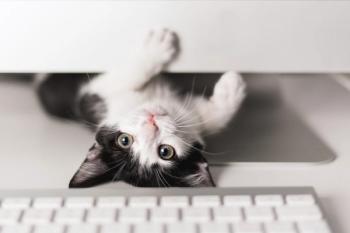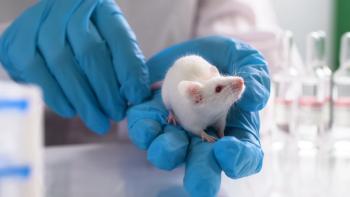
Applied curriculum
Baton Rouge, La. — It's been dubbed the greatest pet rescue in history. When the levees broke in New Orleans following Hurricane Katrina, veterinary students found themselves at the heart of the recovery.
BATON ROUGE, LA. — It's been dubbed the greatest pet rescue in history. When the levees broke in New Orleans following Hurricane Katrina, veterinary students found themselves at the heart of the recovery.
Veterinary student Toby Wallis (left) and a technician help at LSU's intensive care unit.
"I hesitate to even call them students because I consider them colleagues now," says Dr. Denny French, LSU field service professor. He transplanted his hands-on clinical class to Lamar-Dixon Expo Center, a multi-use event facility with emphasis on equestrian and 4-H activities. It became a staging area for equine rescue operations, supply logistics and a temporary shelter for almost 400 horses.
LSU AgCenter's John M. Parker Coliseum was the hub for small animals. It closed Sept. 30 and all animals have been conditionally adopted through local and remote shelters in other parts of the country. But it once bustled with thousands of displaced pets from Hurricane Katrina even though LSU was never part of the state veterinarian's disaster contingency plan.
LSU's Parker Coliseum treated about 2,000 animals with the help of professional volunteers. Sheldon Yessenow, DVM
The animal shelter at the Parker Coliseum opened on Aug. 31. Within 48 hours, more than 500 animals had been received. Veterinarians, technicians and students from the school, as well as volunteer veterinary professionals from all across the country and Canada came to the shelter to help. But students were a staple, so much so that the school offered disaster medicine credits on the fly.
"There was a need for people with clinical training to be at different shelters, and the students really wanted an opportunity to volunteer. So those who had an elective block coming up could transfer to either Parker or Lamar (Lamar-Dixon Expo Center) and were allowed to transfer to this new disaster medicine discipline for two weeks," says Alissa Whitney, fourth-year student at LSU.
Whitney spent several weeks at Parker Coliseum filling several positions as needs arose. With her clinical rotations behind her, she was a go-to person for clinical cases that other students needed help with. But she says the most valuable lessons, ironically, were non-medical.
Technician Amy Breton of VMAT Team-1 examine one of the animals displaced by the hurricanes.
"We didn't want the general-population volunteers handling the biting dogs, so that was my responsibility," she says. "It's a good thing to practice how not to get bit."
She also tended to dogs quarantined for ringworm, scabies, suspected rabies and the like. Her bedside manner had to be honed, too, as overwhelmed human refugees eventually traipsed out of their soaked cities.
"Owners were still very traumatized, and we heard a lot of stories and did a lot of hugging," Whitney says. "It's hard to imagine that in practice there is going to be any more freaked-out people than those who evacuated their flooded homes two hours before. There is a lot of criticism about spending a lot of time and money on animals when those resources could be used to help people, but for so many people, their pet is their family, and if it is all they have left, then it is such an incredible responsibility that they give you because they are handing over their family, and I'm very impressed at the depth of the human/animal bond."
Of course, many animals died in the 36 Louisiana parishes affected by Katrina. The storm roared ashore Monday morning; the 17th Street levee broke by noon, and others followed. Rescue efforts were stalled for two days because it was too dangerous to conduct recovery missions of any kind. The Federal Emergency Management Agency's human and veterinary medical assistance teams began rescue operations on Thursday, but logistical challenges prohibited a citywide sweep for about a week.
"It was really good for me personally and great for my career, but it makes me sick sometimes to think about all the dead animals that I've seen in the past month," says Caren Carney, a third-year LSU student. "There are definitely two sides to it."
Carney went to New Orleans with a contingency from the Humane Society of the United States. They mainly established food and water stations on street corners for stray animals. But there were some gruesome discoveries more than two weeks after almost 12 feet of water engulfed the city.
"If the National Guard found an animal in the houses, then they would write dog or cat or whatever they found on the house, and then we had permission to break into houses to feed and water those animals," she says. "I went 16 days post-storm, and there were a lot of animals that didn't make it 16 days, but there were a lot that did. It's pretty amazing that an animal can live 16 days without food or water."
Carney, student chapter president of American Association of Feline Practitioners, was one of the first student volunteers on the scene at Parker Coliseum, too. She was responsible for setting up the feline ward and establishing protocols for feeding and rounds for volunteers working there.
"I was at the right place at the right time. We showed up on the first day expecting just a couple of animals, and by the end of the first week we had over 200 cats," she says.
The shelter reached its peak numbers Sept. 12, with 1,287 animals. However, each day the shelter was open, pets were admitted and discharged to their owners, so the total number of pets that received care was about 2,000, according to LSU. Medical skills were honed in the process, and a bit of business savvy was picked up as well.
"I definitely improved my leadership skills and learned how to manage people the way I will need to some day if I have my own clinic and need to manage technicians and things like that," she says. "I've already got that first foot into how a clinic might run. I've got that large-scale animal care experience, too."
Equine empathy
Lamar-Dixon wasn't part of the formal disaster plan, either. But by Sept. 1, French and a core group from his clinical field service class converted an empty space into a facility bustling with enough feed, supplies and clinical support for 385 horses with medical charts and electronic identification logs to match.
French is quick to credit the clinical contributions of all the volunteers, especially his students.
"I've been very fortunate to have excellent veterinary students," French says. "They were right here with me the whole time, and they did a phenomenal job of maintaining records and keeping tabs on those that needed treatment."
When DVM Newsmagazine spoke with French more than four weeks after the incident, only one horse was lost at Lamar-Dixon after it arrived.
"I could not have asked for a better learning experience than what I got at Lamar-Dixon," says Amber Slain, a student in the equine field service class. "We were kind of left to make our own decisions and treat the animals how we saw fit, and it was a little scary because we had never been in a situation where we were calling the shots, but it was a confidence builder and made us feel like we were going to make it; we are going to be able to do this when we get out. There were a lot of issues that came up, such as herd health and vaccination status, so it really taught us to think on our feet. We didn't have a history on any of these animals so it was really a challenge medically to figure out the best treatment plans."
She and five cohorts spent more than a month pulling near 18-hour days treating animals and converting refugees to reclaimed pets. The center expected an 80-90 percent return-to-owner rate, something that hasn't been done before due to horse theft and lack of palatable water, according to Bonnie Clark, administrative coordinator at Lamar-Dixon.
"We were so lucky that Lamar-Dixon was so close to the LSU vet school because it was the biggest help that we had," Clark says. "We had vet students do the majority of the treatment, which is great for them; they have an opportunity to see things that they've never seen before and might never see again."
Clark says microchip and tattoo identification, a Louisiana mandate for horses, contributed to the successful return rate. Whitney says permanent ID would have helped many companion animals, too.
"We need to encourage clients that identification of their animals is important," she says. "Collars fall off; something permanent like a microchip or tattoo could be the thing that gets you back to your animal, especially in a situation like this."
Newsletter
From exam room tips to practice management insights, get trusted veterinary news delivered straight to your inbox—subscribe to dvm360.






